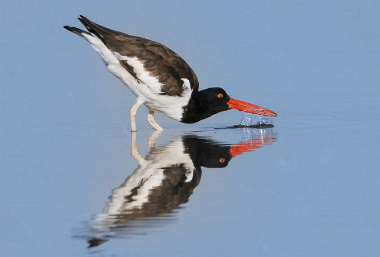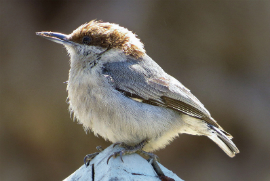This story first appeared in the Charlotte Observer and News & Observer of Raleigh.
 The American oystercatcher is among the 314 birds that National Audubon Society’s recent report considers at risk of losing more than half of its range across the country by 2080. Photo: Meryl Lorenzo/Audubon Photography Awards |
First of a two-part series
North Carolina’s bright summertime landscape of songbirds, seabirds and even game birds like wild turkeys may be in for some drastic changes as the 21st century wears on.
The climate change predicted by many scientists to accelerate rapidly is likely to have many species leaving home in search of cooler, more hospitable climes.
Supporter Spotlight
“For the majority of the birds, especially in the East, it’s going to be a northward shift,” says Tom Auer, Important Bird Area biologist for the National Audubon Society and one of the authors of the society’s recent study on the effects of climate change on North American birds.
In the case of North Carolina’s birds, the move could be westward. The Appalachians beckon with their nearly 6,700-feet elevation, and that, Auer says, “is going to allow species at lower elevations to move uphill as climate change progresses.”
The N.C. mountains already make up the southernmost range for a number of birds, says Curtis Smalling, land bird conservation director for Audubon North Carolina. They include several species of warbler, least and alder flycatchers, and the ruffed grouse.
Some of North Carolina’s most familiar birds are among the 314 that the report considers at risk of losing more than half of their current range across the country by 2080. They include mallards, house finches, ospreys, wild turkeys and, on the coast, black skimmers and American oystercatchers.
Others – including northern cardinals, eastern bluebirds, mockingbirds, Carolina wrens, goldfinches, and downy woodpeckers – are not considered at risk to such a degree.
Supporter Spotlight
Home Sweet Home
“Birds are very similar to us. They can live only within a certain range of temperature, precipitation and seasonal change,” says Heather Hahn, president of Audubon North Carolina.
“If it’s too hot, too cold, too wet, too dry, birds cannot survive.”
The report, which studied 588 species in all, admits that it can’t predict what individual species among the 314 considered at risk will choose to go, but most are likely to move, says Auer.
“They’re migratory species, and that indicates they have the capacity to relocate.”
It’s already happening in some areas, he says.
“The hooded oriole is making a lot of moves farther up into California,” Auer says; and the Acadian flycatcher, which counts N.C. forests among its homes, “has recently really been pushing into New England.”
Those birds caught in changing circumstances are already beginning to suffer, National Audubon President David Yarnold indicated recently as he introduced the report in an NPR interview:
“This year, in southern California, 90 to 95 percent of raptor nests failed,” he said. “There were no baby raptors because of drought.”
The scientists used 40 years of climate information and several decades of Christmas Bird Counts and North American Breeding Bird Surveys to determine the current comfort zones of the 588 species.
What Do Birds Need?
These comfort zones, called “climate envelopes,” consist of the amounts of rainfall, the range in temperatures and the seasonal changes that each species has come to depend upon.
Then they compared these requirements with climate changes predicted by the 2007 report of the United Nations Intergovernmental Panel on Climate Change.
Assuming that the majority of threatened birds will strike out to new territories rather than sit still and perhaps perish, the six scientists conducting the study created animated maps showing places where various species might find compatible climates.
 This little bird is the brown-headed nuthatch, a non-migratory bird that may lose 95 percent of its summer breeding range by 2080. Photo: David Hill/Flickr Creative Commons |
The maps also illustrate likely population shifts in what Auer says is “kind of a best-case scenario for a lot of birds.”
Fans of particular birds can seek them out by name or state on the maps.
But the study, meant to guide future bird conservation efforts, doesn’t tell the whole story, Auer says.
“While the climate may be suitable, the habitat may not be there,” he says. What looks like open space on the map might turn out to be a parking lot or a high-rise.
Work to Do
That’s where bird-lovers come in.
North Carolina has 13,000 Audubon members and 1.5 million North Carolinians who identified themselves as bird watchers in a U.S. Fish and Wildlife survey, according to Hahn.
Besides galvanizing them to work for a reduction in greenhouse gases, she hopes the report will inspire them to create and preserve habitats for both existing birds and those that are to come.
“We need to know that, as they move, they have the habitat they need,” she says.
For her, the report is “a story of hope. We know what they need, and I think we can help them survive.”







